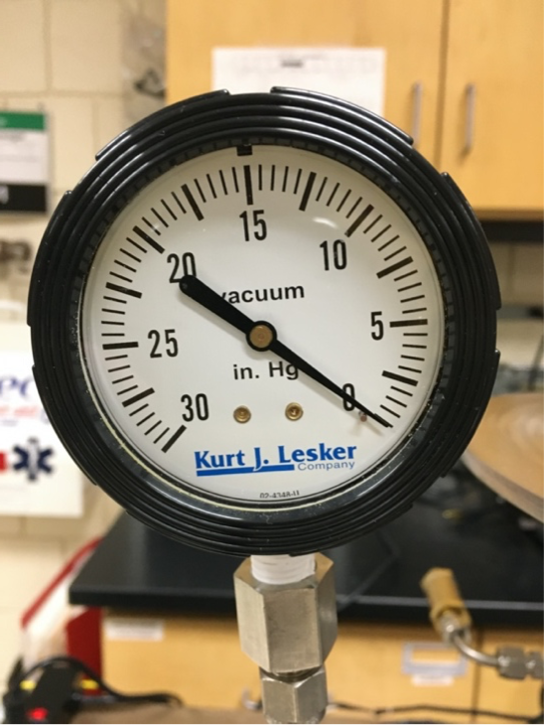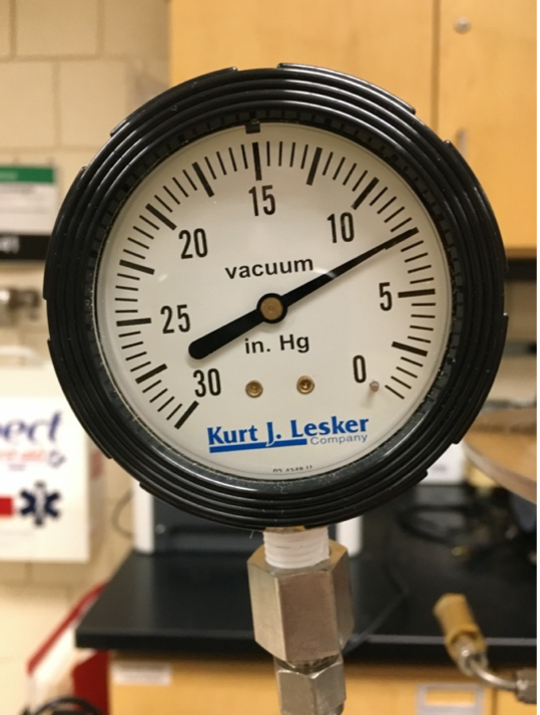Learning Activities 3.1 – 3.4: Unit Conversion, Scientific Notation, Absolute and Gage Pressure, and Pressure Measurement
Summary of Learning Activities
Learning Activity 3.1: Unit Conversion Practice
Learning Activity 3.2: Atmospheric Pressure in Scientific Notation
- Measuring absolute and gage pressure.
- Performing pressure unit conversions.
- Expressing pressure in scientific notation.
- Practice measuring absolute pressure and gage pressure using different pressure measurement devices.
- Practice converting between different pressure units of measure.
- Practice converting gage pressure measurements to an absolute pressure value.
- Express pressure values in scientific notation.
Suggested Pre-lab Assignment
Calculate expected atmospheric pressure for your location using the fact that atmospheric pressure drops by about 1 inch of Mercury for every 1,000 ft of elevation above the sea level. Assume standard atmospheric pressure of 29.92 inches of Mercury (in Hg).
Theoretical Background
Table 3.1. Pressure unit conversion table.
|
To Convert |
Multiply By |
||||||
|---|---|---|---|---|---|---|---|
|
From ----- To |
Pa |
Torr |
Atm |
mbar |
u |
In Hg |
psia |
|
Pascal |
1 |
7.5x10-3 |
9.87x10-6 |
1x10-2 |
7.5 |
2.95x10-4 |
1.45x10-4 |
|
Torr |
133 |
1 |
1.32x10-3 |
1.33 |
1,000 |
3.94x10-2 |
1.93x10-2 |
|
Atm |
1.013x105 |
760 |
1 |
1,013 |
7.6x105 |
29.9 |
14.7 |
|
mbar |
100 |
0.75 |
9.87x10-4 |
1 |
750.1 |
2.95x10-2 |
1.45x10-2 |
|
millitorr or |
0.133 |
1x10-3 |
1.32x10-6 |
1.33x10-3 |
1 |
3.94x10-5 |
1.93x10-5 |
|
In Hg |
3.39x103 |
25.4 |
3.34x10-2 |
33.9 |
2.54x104 |
1 |
0.491 |
|
Psia |
6.90x103 |
51.7 |
6.80x10-2 |
69.0 |
5.17x104 |
2.036 |
1 |
Table 3.1 provides multiplicative factors to convert pressure values from one unit of measure into another. For example, to convert a pressure of 132 Torr to the unit of mbar, locate the unit of torr in the 2nd row in Table 3.1 (highlighted). Since we are converting to the unit of mbar, we will use the 4th column in Table 3.1 (also highlighted). The multiplicative factor to convert from torr to mbar is located at the intersection of this row and column, and that value is 1.33. This means, we multiply the pressure in units of torr by the conversion factor 1.33, to obtain the pressure value in units of mbar:
[latex]\begin{equation} 132 \thinspace Torr \thinspace = \thinspace \left( 132\thinspace \cancel {Torr} \right) \times 1.33 \frac {mbar}{\cancel {Torr}} \thinspace = \thinspace 176 \thinspace mbar. \end{equation}[/latex]
Some pressure measurement devices (gauges) measure absolute pressure, while other gauges measure gage pressure or the amount of pressure above (or below) the atmospheric pressure. Equation 3.1 below shows the relationship between absolute, atmospheric, and gage pressures:
[latex]\begin{equation} P_{absolute} \thinspace = \thinspace P_{gage} \thinspace + \thinspace P_{atmospheric} \qquad \qquad \left( Eq.3.1 \right) \end{equation}[/latex]
An example of a gage pressure measurement device is the Bourdon gauge. Some examples of absolute pressure measurement devices used with vacuum systems are the capacitance diaphragm, Pirani, convection-enhanced Pirani, and thermocouple gauges.
A Bourdon gauge is a confusing pressure measurement device for interpreting the measurement readings. Figure 3.1 below shows a Bourdon gauge at atmospheric pressure. The reading needle is at 0 in Hg Vacuum, indicating that the measured pressure is exactly at atmospheric pressure.

When measured pressure is below atmospheric pressure, that is, when a vacuum condition is present, a Bourdon gauge will indicate a value representing the amount of pressure below atmospheric pressure. For example, Figure 3.2 shows a Bourdon gauge reading of 7.6 in Hg Vacuum or 7.6 in Hg below atmospheric pressure (or – 7.6 in Hg):
[latex]\begin{equation} P_{gage} \thinspace = \thinspace 7.6 \thinspace in \thinspace Hg \thinspace Vacuum \thinspace = \thinspace -7.6 \thinspace in \thinspace Hg \end{equation}[/latex]
Note that a below-atmospheric gage pressure value should be negative, Pgage = -7.6 in Hg, when performing absolute pressure calculations. To convert this value to the absolute pressure, we need to know atmospheric pressure at this location. If atmospheric pressure is Patm= 29.9 in Hg, then:
[latex]\begin{equation} P_{absolute} \thinspace = \thinspace -7.6 \thinspace in \thinspace Hg \thinspace + \thinspace 29.9 \thinspace in \thinspace Hg \thinspace = \thinspace 22.3 \thinspace in \thinspace Hg \end{equation}[/latex]
or 22.3 in Hg above absolute zero pressure. Some Bourdon gauges may show pressure values below atmosphere as negative pressure, instead of stating “Vacuum”. This will depend on the display design of the particular Bourdon gauge device.

If atmospheric pressure is measured in a unit of measure other than the unit used by the Bourdon gauge (for example, torr), then the Bourdon gauge reading needs to be converted to that other pressure unit before calculating absolute pressure. If atmospheric pressure was measured as 760 Torr, we will need to convert Pgage= - 7.6 in Hg to Torr:
[latex]\begin{equation} -7.6 \thinspace in \thinspace Hg \thinspace = \thinspace \left( -7.6 \thinspace \cancel {in \thinspace Hg} \right) \times 25.4 \frac {Torr}{\cancel {in \thinspace Hg}} \thinspace = \thinspace -193 \thinspace Torr \end{equation}[/latex]
then, to calculate absolute pressure:
[latex]\begin{equation} P_{absolute} = -193 \thinspace Torr + 760 \thinspace Torr = 567 \thinspace Torr. \end{equation}[/latex]
Equipment and Materials
- Rough Vacuum Equipment Trainer (RVET) system
- Unit conversion table (Table 3.1)
Procedure
Learning Activity 3.1: Unit Conversion Practice
- Refer to the marshmallow weight calculated in the after-class assignment of the Learning Activity 2.4. Using Table 3.1, convert the pressure due to the marshmallow’s weight from:
a. Pascals (Pa) to atmospheres (atm),
b. Pascals (Pa) to Torr. - Using Table 3.1, convert the reading of the absolute pressure gauge (capacitance manometer, Pirani gauge, or other) to:
a. Pascals (Pa),
b. atmospheres (atm).Absolute pressure gauge reading: ____________ Unit: __________
- What is the pressure exerted by each tire on a 1,400 kg pickup truck if each tire makes contact with 37 in2 of the road surface? Write your answer in units of Pa, torr, and psia.
- Tire pressure is about 35 psi. Is this absolute or gage pressure?
- Convert 35.0 psig to Pa, atm, and torr, assuming standard atmospheric pressure of 14.7 psi.
Learning Activity 3.2: Atmospheric Pressure in Scientific Notation
- Vent RVET to atmosphere.
- Set absolute pressure reading gauge to reading in units of torr and in scientific notation.
- Read the absolute pressure reading gauge for a measurement of atmospheric pressure and record in the Table 3.2 below.
- Repeat step 3 for a second measurement of atmospheric pressure. Record in Table 3.2.
Table 3.2. Pressure Data Table. Date data collected: _________
Location
Reading 1 from the absolute pressure reading gauge (Torr)
Reading 2 from the absolute pressure reading gauge (Torr)
Convert these readings to decimal notation and record in Table 3.3.
Table 3.3. Pressure Data in Decimal Notation Table.
Date data collected: _____________
|
Location |
Reading 1 in Decimal Notation (Torr) |
Reading 2 in Decimal Notation (Torr) |
|---|---|---|
|
|
|
|
Learning Activity 3.3: Expected Atmospheric Pressure
- Use an internet search tool (e.g. Google) to look up the expected atmospheric pressure at the following locations. Record each value in the middle column of Table 3.4 with the units that were given. Then record this value in torr in the last column. You may need to do some unit conversions.
Table 3.4. Atmospheric Pressure Data Table.
Location
Expected Atmospheric Pressure with units
Expected atmospheric Pressure (Torr)
Location 1: Your location
Location 2: Denver, Co (altitude of 5,279 feet)
Location 3: Miami, FL (altitude of 7 feet)
Location 4:
Location 5:
For each location, are the pressures you found the same as the pressures that would be read from RVET at the instructional site? If they are not, list some reasons why they might be different.
Learning Activity 3.4: Pressure in Scientific Notation
- Record the value of atmospheric pressure from the Bourdon gauge for your location. Record in the Table 3.5 below.
Table 3.5. Bourdon Gauge Reading of Atmospheric Pressure Table.
Location
Reading from the Bourdon Gauge (in Hg Vacuum): Atmospheric Pressure
What should this value be?
Close the vacuum chamber and venting valve.
Turn on the pump.
Open the roughing valve.
Pump down for approximately 10 seconds, then close the roughing valve.
Record the pressure measurement reading from the gage pressure measurement gauge as the value for Pressure 1 in Table 3.6.
Open the roughing valve.
Pump down for approximately 10 seconds, then close the roughing valve.
Record the pressure measurement reading from the gage pressure measurement gauge as the value for Pressure 2 in Table 3.6.
Table 3.6. Gage Pressure Data Table.
|
Location |
Pressure 1 from the Bourdon Gauge (in Hg Vacuum) |
Pressure 2 from the Bourdon Gauge (in Hg Vacuum) |
|---|---|---|
|
|
|
|
Convert these measurements to absolute pressure in torr and record in Table 3.7.
Table 3.7. Absolute Pressure Data Table.
|
Location |
Absolute Pressure (Torr) |
Absolute Pressure (Torr) |
|---|---|---|
|
|
|
|
Measure the pressure measured by the absolute pressure reading gauge and record in Table 3.8.
Table 3.8. Absolute Pressure Data Table.
|
Location |
Pressure 2 from Absolute Pressure Reading Gauge (Torr) |
|---|---|
|
|
|
How does the measurement from the absolute pressure measurement gauge compare to the calculated absolute pressure from the gage measurement device? How should the two values compare?
What is the relationship between the measurement values obtained from the Bourdon gauge and the absolute pressure reading gauge (capacitance manometer or Pirani gauge)? What type of measurement does the capacitance diaphragm gauge make: absolute or gage? What type of measurement does the Bourdon gauge make: absolute or gage?

This work is supported by the National Science Foundation under grant number ATE DUE 2000454. Any opinions, findings, and conclusions or recommendations expressed in this e-book are those of the authors and do not necessarily reflect the views of the National Science Foundation.
Media Attributions
- Figure 3.1. © Nancy Louwagie, Normandale Community College is licensed under a CC BY-NC-SA (Attribution NonCommercial ShareAlike) license
- Figure 3.2. © Nancy Louwagie is licensed under a CC BY-NC-SA (Attribution NonCommercial ShareAlike) license

